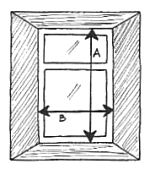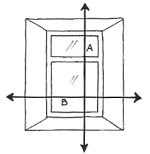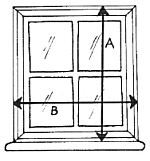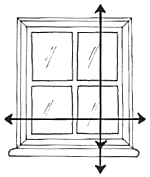| Measuring for a roman blind | | Fitting |
| What You Need
- Steel tape measure calibrated in centimetres.
- Someone to help if the windows is especially wide or long.
- Pen and paper.
What type of window do you have?
- Check the window to see if it is in a recess or not (the window frame fits flat against the wall)
- Stand in front of the window.
- Does it recede deeply into the wall to a depth of at least 10 cm, with the windowframe laying flush to the wall outside? Probably with a deep window sill. If it does you have a recessed window.
- Or does the frame sit in line with the wall on the inside ie in the room. Probably the windowsill is very shallow. If it does, you have a non-recessed window.
- If you want a shaped or zigzag bottom, note that the drop measurement includes the bottom section.
Measuring in a Recess
A window in a recess is where the window is 'sunk in' to the wall.
You have two options:
Option (1) Fit the blind in the recess
The advantages are:
- It makes for a very neat finish.
- The blind batten can be fixed onto the window frame if it is wood, which is an easier fixing to do.
 The disadvantages are:
The disadvantages are:
- When pulled up, the blind will obscure part of the window allowing less light through, which may be a problem if the window is small.
- If the bottom of the blind is shaped, light will come through at the base of the window when the blind is down. This is only really a consideration if the window is in a bedroom.
To measure the recess:
- Take the measurement from the top to the bottom of the recess. Do this at either end of the window and once in the middle if the window is wide, to check for irregularities. Take the smallest measurement and deduct 1 cm from this. This is the length, or 'drop' of the blind.
- Next, measure from one side of the recess to the other side. Again, do this in more than one place to check for irregularities and take the smallest measurement. Deduct 1cm from this- this is the width of your blind.~
- Be careful when measuring the width, of anything that will affect this measurement eg picture or dado rails that come into the recess or thick tiles in kitchens or bathrooms that come part-way up the recess. Obviously, such things will make the width of the blind that much narrower.
Option (2) Fit the blind outside the recess onto the surrounding wall.
The advantages are:
- It gets around the problems of picture or dado rails as discussed above, or inward opening windows. It also won't affect ornaments etc if these are placed on the sill.
- As the blind batten is fixed above the recess, the blind will fold up fully or partly above the window and will not affect light levels so much.
- As the blind bottom comes down below the window, if it is shaped, it will still keep the light out ( a potential issue in bedrooms).
 The disadvantages are:
The disadvantages are:
- The blind batten may be going into a concrete lintel which is a harder fixing.
- If you have objects you wish to display in the recess, then they will be obscured from view when the blind is let down.
To measure outside the recess:
- Decide how far outside the recess the blind will extend - 5 to 10cm either side. This is the width of your blind.
- Work out where your blind bottom will sit - this will usually be 10-20cm above the window. Generally, you will want the blind when folded, so sit above the window, but to cover the top part of the windowframe. Measure from this point to 5-10cm below the recess. This is the length of the blind.
Measuring a non-recessed window
A non-recessed window is one that lies flat against the wall. You have two options:
Option (1) Fix To The Architrave

- Blinds on these windows can usually be fixed onto the wood architrave surrounding the window. Fixing the blind batten into wood is always easier than fixing into the wall. You can choose to have the blind drop to the windowsill or below it (if the sill does not jut out too much). You might want to drop below the windowsill for aesthetic or light reasons.
- For the length, measure from the top of the architrave to the top of the sill or appoint 5-10cm below it (A). Measure twice on either side for irregularities and take the smallest measurement if there is a discrepancy.
- For the width, measure from the outside edge of the architrave across to the other side (B). Measure twice for irregularities, but this time if there is a difference take the larger measurement.
Option (2) Fix To The Wall Above The Window

- If there is no wood around the window, you will need to fix to the wall above. You may wish to make your blind bigger than the actual window size.
- To measure the length, work out where your blind batten will sit - either just above the frame so that he blind will fold up and cover the top part of the window, or 10-20cm above the window so that when folded only the bottom folds of the blind cover the top of the windowframe. Measure from this point to the windowsill or 5-10cm below it (A) (depending on whether you want to obscure the windowsill or not). Measure twice on either side for irregularities and take the smallest measurement.
- For the width, decide how far outside the frame your blind will extend - 5cm to 10cm according to choice - and take this measurement (B). You do not have to overlap 5cm to 10cm in this way - you could just make the width of the blind the same as the windowframe depending on personal taste.
Bay Windows
- Bay windows are never considered to be in a recess - you have to look them as non-recessed and look to fitting in one of the two ways described above. The issues that arise are:
- Batten length: Extra care needs to be taken that you don't order blinds that are too wide, particularly for the central section.
- Gap: You want a cm or two gap between the blinds so that they do not interfere with each other when being raised or lowered.
- Stringing: It is fine to have each blind with a separate drawstring. However, you can link the drawstrings of any two of the blinds together quite simply. You just have to order one left strung and one right strung and you can link them together.
- Let us know:tell us if your blinds are part of a bay arrangement (we'll probably know anyway), in the 'special instructions' section of the order form.
Face-fitting and Top-fitting
- If the blind is to be fitted to a vertical surface, such as a wall or architrave, this is termed face-fitting.
- If the blind is to be fitted underneat a horizontal surface, such as a ceiling or alcove ceiling, this is termed top-fitting.
The reason for telling us this when you order is not that big a deal. It's just that we pre-drill the holes through the wooden mounting batten, to make fitting a bit easier, and we obviously drill in a different direction for face and top fitting. If you get this bit wrong you can always re-drill the holes yourself, but you might as well think about it and get it right!
Special Circumstances
- Windowsills: You need to decide whether to go below the sill or sit on top. If you have a shaped bottom to your blind, remember these will let light in at the base if they lay above the sill.
- Windows that open inwards. Beware! Sometimes an inward-opening window may have a supporting bracket that is a significant protrusion that may have to be adjusted or removed to fit a blind. In general, if a window opens inwards, you cannot fit the blind in the recess and you have to allow sufficient distance between the blind and the window.
- Blinds Over Doors: Check Jutting out objects eg door handles .If possible the blind should be made so it can sit inside the handle.
- Similarly, jutting objects on window handles,locks on security bars, can all cause a blind to snag and not pull up properly. If possible, position the bottom so that the blind comes in front of such obstacles, or just release the blind from the obstacle with your hand as it pulls up.
- Wonky Windows. Blinds need to fall straight. There is only limited adjustment you can do when you fit the blind, to allow for a window that is not straight. A shaped bottom will help distract the eye from a windowsill that is not truly level.
- Extending the blind outside the frame is better. Roman blinds have a structured feel with string, clean lines that will accentuate 'wonkiness'. If symmetry is important to you it may be better not to choose these blinds.
|

























